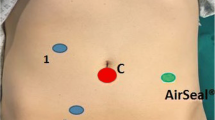Abstract
Background
The splenic flexure (SF) anatomy is complex due to multiple vessels, surrounding organs, layers, and irregular adhesions [1,2,3].
Methods
Our laparoscopic approach involves a lateral-to-medial approach to the left-sided transverse mesocolon (TM), a medial-to-lateral approach to the left mesocolon (LM), and take-down of the remnant SF. First, the omental bursa is opened and its posterior wall and the anterior layer of the TM are dissected along the pancreas, where a gauze is placed. The TM is spread cephalad. A window in the TM is opened in the gauze seen through the TM. If necessary, the middle colic vessels are divided with lymph node (LN) dissection. Then the left colic artery is divided with LN dissection using a medial approach. The LM is widely dissected from the retroperitoneum to reach the TM window. While observing the pancreas through the window, the LM and TM are divided from the pancreas close to the SF. The descending colon is mobilized from its lateral attachment. Finally, the SF is taken down from the spleen by separating remnant structures, including adhesions. Subsequently, functional end-to-end anastomosis was performed extracorporeally.
Results
During March 2012–December 2016, 39 patients with left-sided transverse or descending colon cancer underwent this treatment. The mean operative time, blood loss, number of harvested LNs, and hospital stay duration were 283 min, 45 ml, 15, and 9 days, respectively. No patient needed conversion to open surgery or had organ injury, anastomotic leakage, or Clavien–Dindo III–V complications. There were 7/13/18/1 patients with Stage I/II/III/IV colon cancer, respectively. Nineteen cases had positive LNs. All patients were alive with one local and two distant recurrences at a mean 24-month follow-up.
Conclusions
This is a safe and effective surgical strategy for treating colon cancer of the SF, strategically designed to resect the SF after dissecting the surrounding structures.
Article PDF
Similar content being viewed by others
References
Robillard GL, Shapiro AL (1947) Variational anatomy of the middle colic artery; its significance in gastric and colonic surgery. J Int Coll Surg 10:157–169
Koizumi M, Horiguchi M (1990) Accessory arteries supplying the human transverse colon. Acta Anat 137:246–251
Jeong YJ, Cho BH, Kinugasa Y, Song CH, Hirai I, Kimura W, Fujimiya M, Murakami G (2009) Fetal topohistology of the mesocolon transversum with special reference to fusion with other mesenteries and fasciae. Clin Anat 22:716–729. doi:10.1002/ca.20846
Author information
Authors and Affiliations
Corresponding author
Ethics declarations
Disclosures
Drs. Naoki Matsumura, Hiromi Tokumura, Fumito Saijo, and Yu Katayose have no conflicts of interest and financial ties to disclose.
Electronic supplementary material
Below is the link to the electronic supplementary material.
Supplementary material 1 (WMV 239509 KB)
Rights and permissions
About this article
Cite this article
Matsumura, N., Tokumura, H., Saijo, F. et al. Strategy of laparoscopic surgery for colon cancer of the splenic flexure: a novel approach. Surg Endosc 32, 2559 (2018). https://doi.org/10.1007/s00464-017-5870-9
Received:
Accepted:
Published:
Issue Date:
DOI: https://doi.org/10.1007/s00464-017-5870-9




